From Roosevelt to Resolute, The Secrets of All 6 Oval Office Desks
Nothing says “presidential” like a stately hunk of wood polished to a gleam.
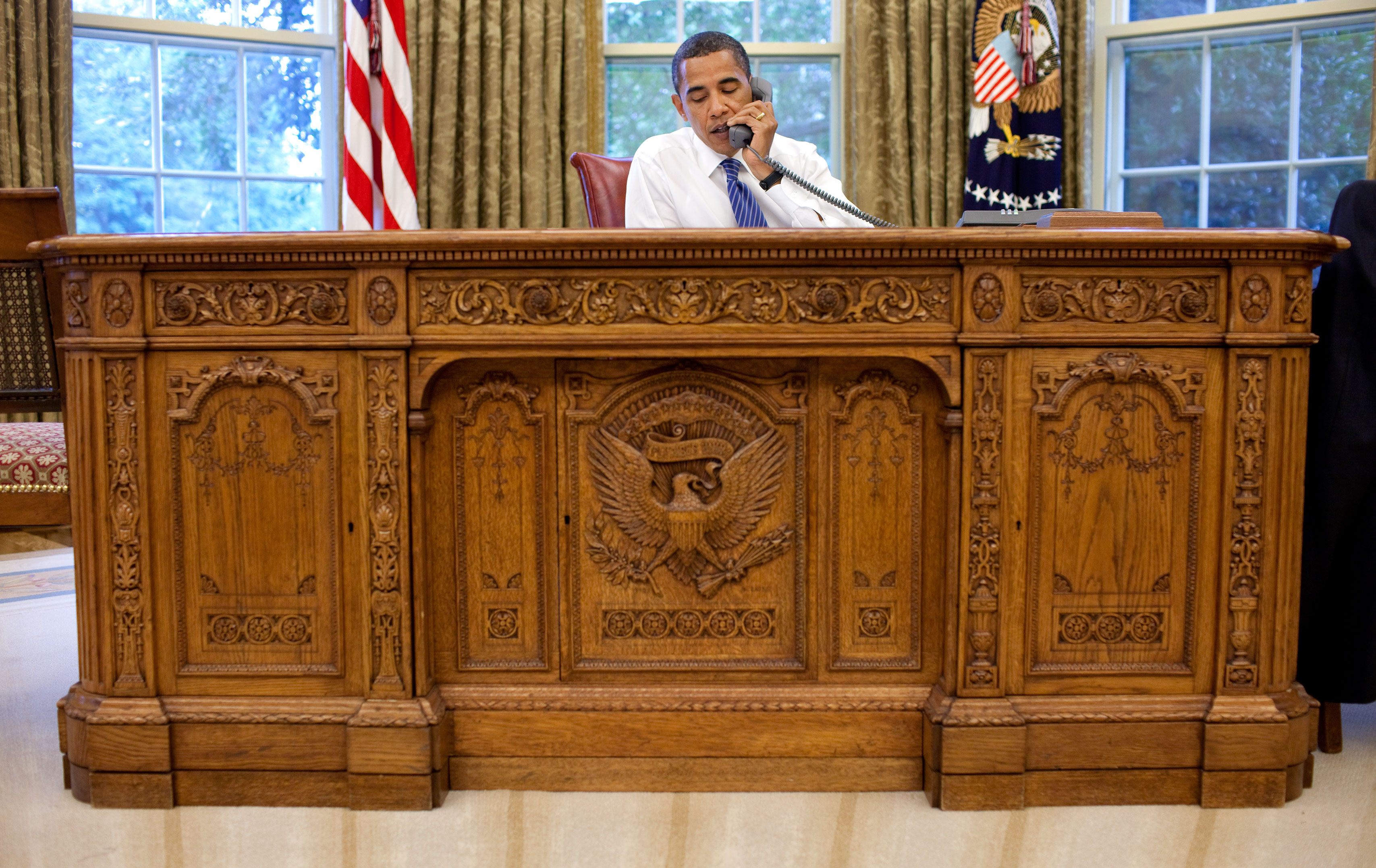
The Resolute Desk is the greatest of the presidential desks. (Photo: Pete Souza/Public Domain)
Whenever a new president comes takes over the Oval Office, they’ve got to make some big, impactful decisions. Among them, what desk to use in their new seat of power?
There have only ever been six desks to pass through this room, each chosen by the president who must use it for business that could change the world. Whether it was used for one term or one century, every one of the double-wide, two-pillar Oval Office desks has a compelling story. Here are these fascinating bits of furniture—ranked.
6. The C+O Desk

George H.W. Bush and some fresh-faced cabinet members. (Photo: Susan Biddle/Public Domain)
Spending only one term in the Oval Office, literally serving under President H.W. Bush, the C+O desk holds the record for the shortest-lived of all the president’s desks. But that doesn’t mean it isn’t special.
The utilitarian desk was first built in 1920 by the Chesapeake and Ohio Railway (C+O), to be used as one of the company owners’ personal desks. After a series of mergers, the company that was once C+O donated the desk to the White House, where it was placed in the Oval Office Study. In 1985, during H.W. Bush’s time as Vice President under Ronald Reagan, he commandeered the desk for himself and moved it to his office. When H.W. Bush rose to the presidency in 1989, he brought his beloved desk with him to the Oval Office proper, sending its predecessor, the Resolute Desk (see below) into storage for the duration of his single term in office.

A replica of the desk in the G. H. W. Bush Library. (Photo: George Bush Presidential Library and Museum/CC BY 2.0)
Made of humble walnut, the C+O desk itself is relatively unadorned as far as the desks of world leaders go. It is a stately, Georgian workspace with drawers and cabinets set into either side of the two wide pillars that support the desktop. It is stained a deep brown, and set with golden handles. A classy, if not flashy piece of furniture.
Incoming president Bill Clinton, who took office in 1993, did not share H.W. Bush’s love for the stoic C+O Desk, and returned the Resolute Desk to the Oval Office when he got there. A replica of the nation’s only one-term desk can now be found in the George H.W. Bush Library in College Station, Texas.
5. The Hoover Desk

Wait, that’s not Herbert Hoover. (Photo: National Archives and Records Administration/Public Domain)
While it is named after Herbert Hoover, this sturdy utilitarian desk got much more use from four-term New Deal inventor Franklin Delano Roosevelt, who used it throughout his 12 years as Commander-in-Chief.
In December of 1929, during President Hoover’s single term in office, a fire (caused either by a blocked chimney or faulty wiring) raged through the West Wing of the White House, gutting many of the chambers including the Oval Office. Hoover had been using the Roosevelt Desk that had sat in the Oval Office since its founding. The Roosevelt Desk was saved, but after the fire, it was time for a change. In 1930, the Grand Rapids Furniture Manufacturer’s Association donated a brand new desk to Hoover, who had it installed in his rebuilt Oval Office.

The desk today. (Photo: FDR Presidential Library/CC BY 2.0)
This new desk was a darkly stained, two-pillar desk. It only had drawers and cabinets on the President’s side, while the side facing out featured subtle Art Deco angles as its only decoration.
When FDR ascended to the presidency in 1933, he didn’t bother changing any of the furniture in the Oval Office and continued to use the Hoover Desk for the duration of his presidency. It was at this desk that FDR signed declarations of war with Japan and Germany during World War II.
When Harry Truman took over the presidency in 1945 after Roosevelt’s death, he had the Roosevelt Desk put back in the Oval Office. FDR’s original Hoover Desk is now held in his presidential library, still covered in knick-knacks and gifts from admirers.
4. The Johnson Desk

LBJ doin’ business. (Photo: LBJ Library/Public Domain)
Lyndon B. Johnson moved into the Oval Office in 1963 after the assassination of John F. Kennedy. Whether out of sadness at Kennedy’s death, or his own personal comfort, Johnson moved in his own desk that he had been using for years.
The Johnson Desk was not donated to the White House, but purpose built for government work by the Senate Cabinet Shop some time between 1906 and 1926. Johnson first used the desk during his years on the Senate, bringing it with him to his brief stint as Vice President, and eventually moving it into the Oval Office when he assumed the presidency.
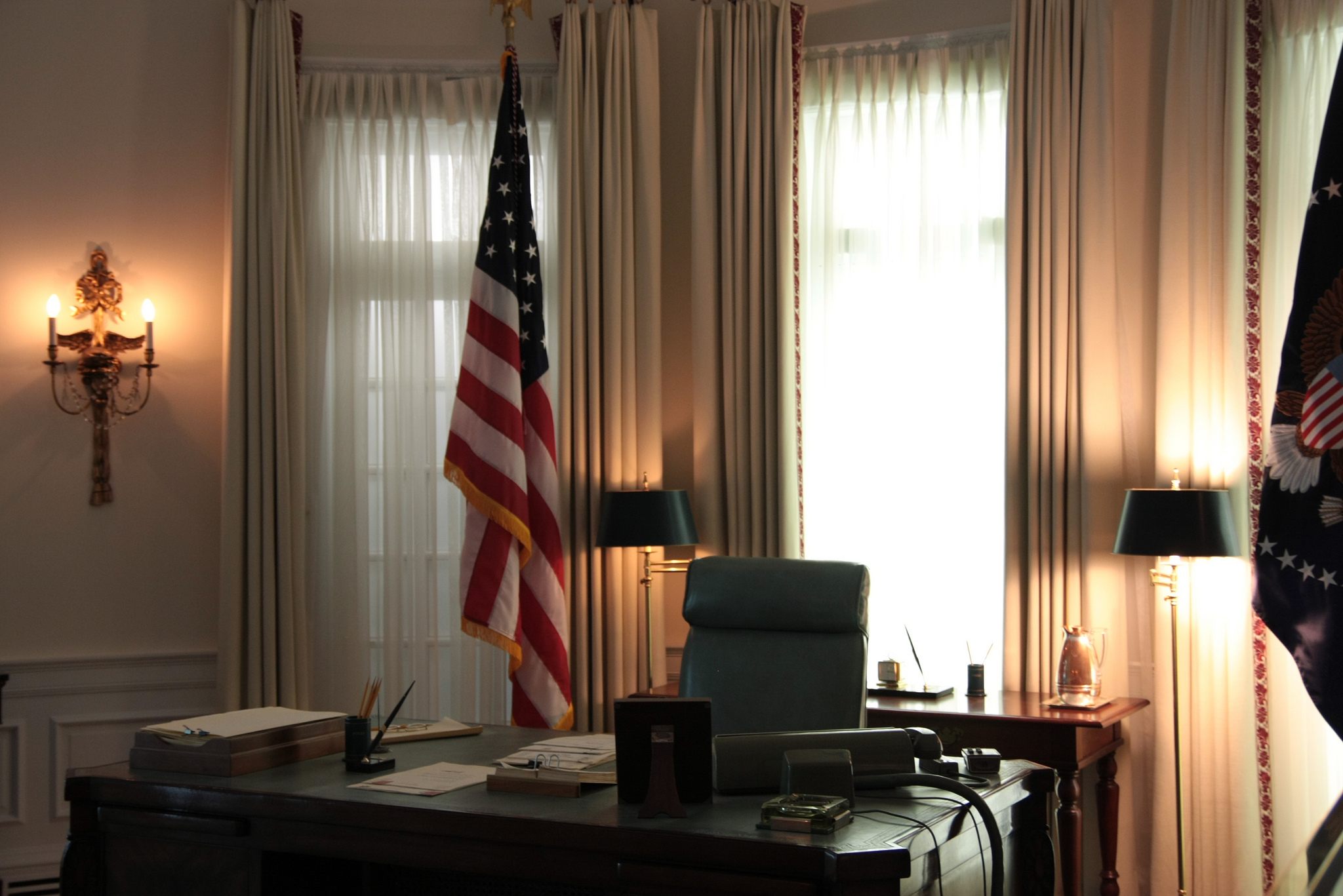
The desk in the LBJ museum. (Photo: Miles Heller/CC BY-SA 2.0)
The Johnson Desk is another two-pillar with cabinets on either side. It is made of mahogany, and designed in the rounded, classical style of all the Senate floor furniture, with decorative curves and bulbous feet. However, the most striking feature of the desk, and the biggest way that it differs from all of the other Oval Office desks, is that it is the only one to be topped with garish green leather.
Given its rather loud desktop, it’s little wonder that the Johnson Desk only lasted during his presidency, being replaced when Richard Nixon succeeded Johnson. The desk was eventually moved to the Oval Office replica in Johnson’s presidential library. Supposedly Johnson himself would occasionally sit behind it, waiting to scare unsuspecting visitors.
3. The Wilson Desk
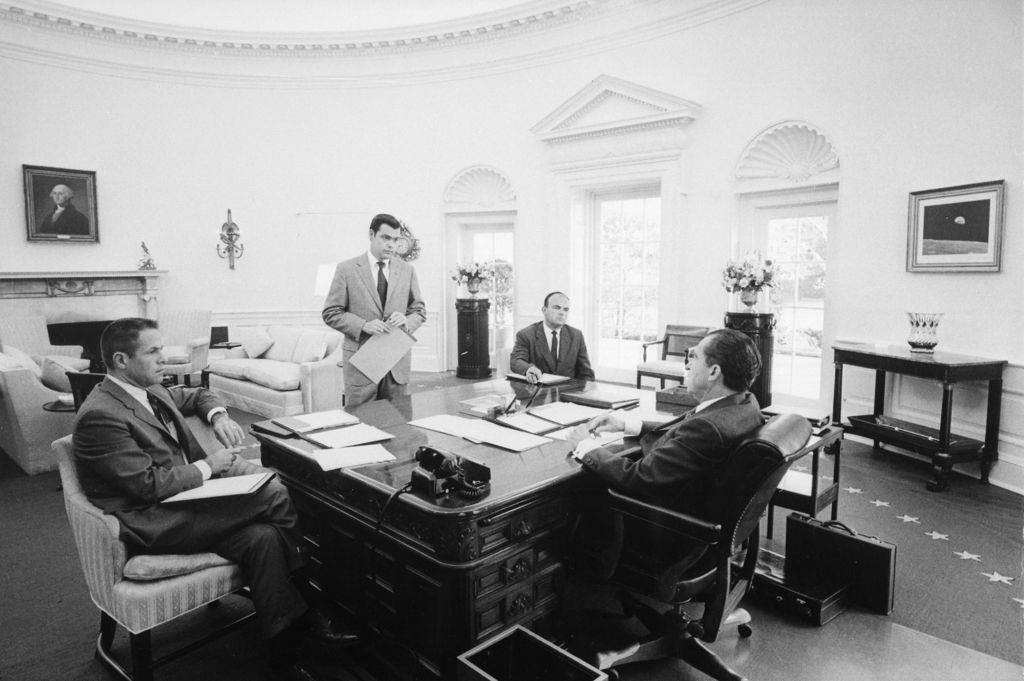
Nixon talks with advisors over the Wilson Desk. Probably recording. (Photo: NARA/Public Domain)
This is the desk that tricked “Tricky” Dick Nixon, who chose to make it the centerpiece of the Oval Office under the belief that it had once been used by a respected predecessor: Woodrow Wilson, 28th President of the United States.
The Wilson Desk came to Nixon after having been purchased in the late 1800s to decorate the Vice President’s chambers in the Capitol Building. The imposing mahogany desk shared the popular two-pedestal-style of many others, with drawers on either side. The desk remained in the Capitol Building through the terms of 15 separate Vice Presidents, including Nixon himself, who clearly took a liking to it.
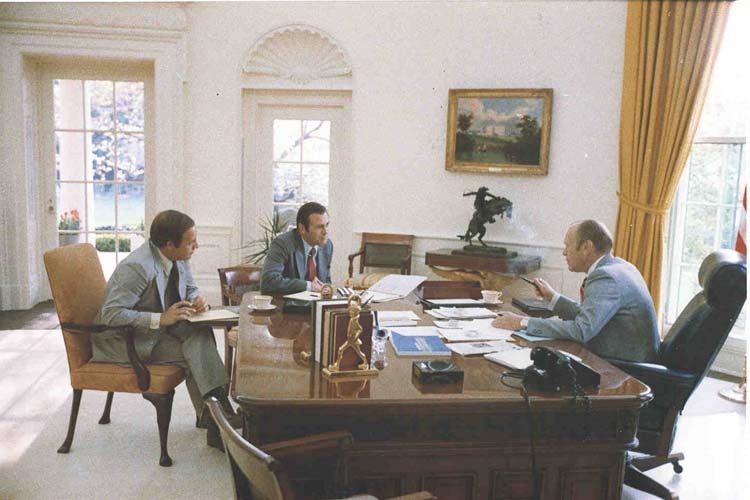
Gerald Ford talks with a young Rumsfeld and Cheney (Photo: Wikipedia/Public Domain)
When Nixon took office, he had the desk moved into the Oval Office, using it as a feature of his “Silent Majority” speech on the Vietnam War, in which he invoked Woodrow Wilson’s words about World War I. However, as a White House curator discovered, it was called the Wilson Desk because it was said to have been used by Henry Wilson, 18th Vice President of the United States. Whoops.
Nixon was informed of the mix-up but didn’t seem to care, and continued using the desk. This may have had to do with the fact that he had ordered the Secret Service to install five hidden microphones in it. These voice-activated (later Nixon installed a switch to turn them on and off) recorders secretly taped a number of Oval Office conversations that would later comprise a portion of the Watergate Tapes.
Once the Watergate scandal forced Nixon out of office, and Gerald Ford took over, the desk remained in the Oval Office throughout Ford’s time as president. When Ford left office, the desk was returned to the Vice President’s office in the Capitol Building where it is still in use. The fate of the secret microphones is unclear.
2. The Roosevelt Desk

The Roosevelt Desk in 1909, ready for Taft. (Photo: GearedBull/Public Domain)
The Theodore Roosevelt Desk was not only the first desk to sit in the Oval Office, but it has also been used by more presidents than any other Oval Office desk, with seven CiC’s choosing it as their workstation.
As the name implies, the desk was built in 1903 for President Theodore Roosevelt, the driving force behind the creation of the White House’s West Wing. It was designed by Charles Follen McKim, of famed architectural firm McKim, Mead & White, who designed the original West Wing.
The desk was moved from Roosevelt’s proto-Oval Office when President William Taft came into office and expanded the Executive Building, creating the first Oval Office as we know it today. The desk remained in the office for decades, dutifully serving under Woodrow Wilson, Warren G. Harding, Calvin Coolidge, and Herbert Hoover. It was not until the 1929 fire that saw the introduction of the Hoover Desk, that the Roosevelt Desk was removed. Unhurt by the fire thanks to someone throwing a tarp over it, the desk was placed in storage for 16 years.

Dick Cheney signs the top drawer of the desk (Photo: David Bohrer/Public Domain)
It was Harry S. Truman who brought the desk out of storage for his presidency, putting it back in the Oval Office in 1945. Truman used the reliable old desk for the duration of his presidency, and began a tradition of signing the inside of the top drawer. Following Truman, Dwight D. Eisenhower also chose to use the desk as his official Oval Office workspace.
The Roosevelt Desk finally left the Oval Office for good in 1961 when John F. Kennedy moved it to Vice President Lyndon Johnson’s office. The desk has remained in use by Vice Presidents ever since, its top drawer gathering another signature with each new administration.
1. The Resolute Desk

The Gipper hard at work at the Resolute Desk (Photo: Ronald Reagan Presidential Library/Public Domain)
Built from a shipwreck, and containing a secret door to hide FDR’s legs, the Resolute Desk is far and away the greatest of the presidential desks.
The Resolute Desk first came to America in 1879, given to Rutherford B. Hayes as a gift from Queen Victoria, but its history goes back a little farther. The HMS Resolute was a British naval vessel that had been abandoned in unnavigable arctic pack ice in 1853. When the ice thawed, releasing the ship, it drifted away, eventually being discovered by an American whaling vessel.
The ship was sailed back to America where it was fixed up at the Brooklyn Navy Yard, and then sailed back to Britain as a goodwill gift. The Resolute never saw much action after that and was broken down in 1879. Queen Victoria fired the next salvo in the war of kindness when she had the oak timbers of the ship used to create what is now the Resolute Desk.
According to Victoria’s orders, the ornately adorned desk is covered in carved designs, filigree, and scrollwork. There is also a plaque commemorating the origin of the incredible piece of furniture. The top, like the Johnson Desk but not as garish, is set with red leather.
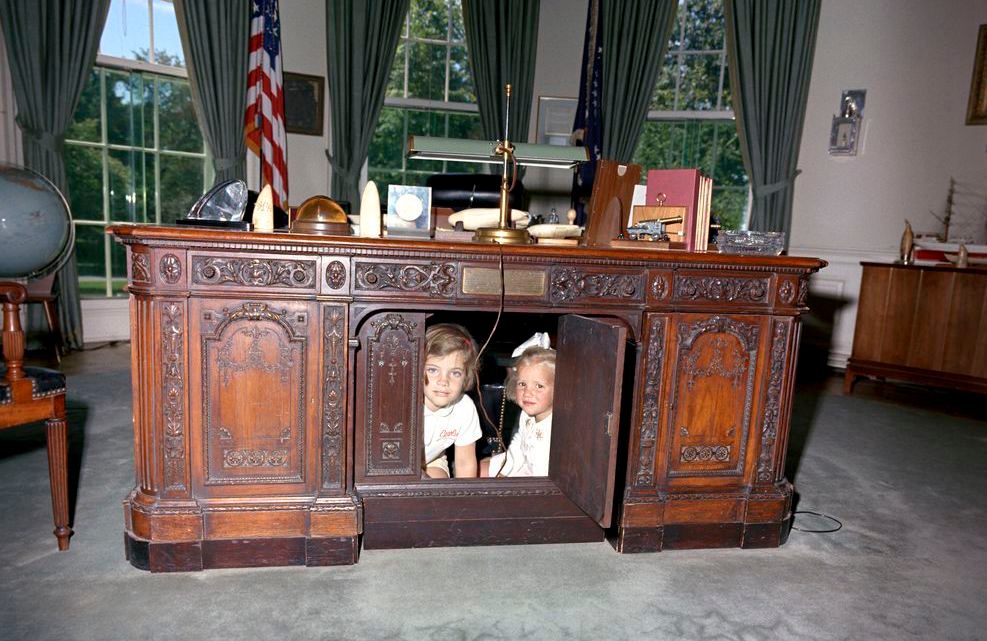
A couple of Kennedys use FDR’s leg hole to play around (Photo: Harold Sellers/Public Domain)
After the desk made it to America it was placed in the White House, in the President’s Study. While there, Franklin D. Roosevelt, having to wear leg braces due to his polio, had a modesty panel installed in the desk that covered the knee hole. It was fitted with a hinged panel that could open like a secret door, emblazoned with a carved presidential seal—one of the few seals in the White House that features the eagle facing the arrows instead of the olive branches.
The Resolute Desk did not make it to the Oval Office until the presidency of John F. Kennedy, but it was not he who chose to put it there. It was First Lady Jacqueline Kennedy who found the Resolute Desk, then forgotten in a White House broadcasting room, and had it installed in the Oval Office as part of her overall restoration of the White House.
After Kennedy’s assassination, LBJ removed the Resolute Desk from the Oval Office. It didn’t return until Jimmy Carter was elected and chose to once again use the ornate desk as his presidential throne. It has remained the Oval Office desk of every president since—with the exception of George H.W. Bush—serving Ronald Reagan, Bill Clinton, George W. Bush, and now Barack Obama.
Obama has taken some heat for pictures showing him with his feet up on the desk, but considering that it is made from wood that survived the Arctic Sea and six presidencies, it’ll probably be just fine.
Update (4/7): The article originally stated that JFK was assassinated in 1961. The date has been corrected to 1963.








Follow us on Twitter to get the latest on the world's hidden wonders.
Like us on Facebook to get the latest on the world's hidden wonders.
Follow us on Twitter Like us on Facebook